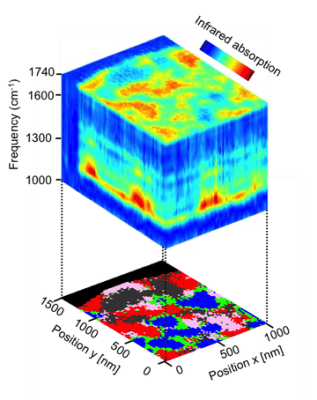Feb 24 2017
 Nanoscale-resolved hyperspectral infrared data cube of a polymer blend, comprising 5000 nano-FTIR spectra (top panel). The data cube can be divided into clusters (by hierarchical cluster analysis) and thus converted into a compositional map (bottom panel). It reveals the polymer components (grey, blue and red areas), as well as the interfaces between them (green areas) that partially exhibit anomalies that are explained by chemical interaction (purple areas). Credit: CIC nanoGUNE
Nanoscale-resolved hyperspectral infrared data cube of a polymer blend, comprising 5000 nano-FTIR spectra (top panel). The data cube can be divided into clusters (by hierarchical cluster analysis) and thus converted into a compositional map (bottom panel). It reveals the polymer components (grey, blue and red areas), as well as the interfaces between them (green areas) that partially exhibit anomalies that are explained by chemical interaction (purple areas). Credit: CIC nanoGUNE
The development of hyperspectral infrared nanoimaging has been reported by a team of researchers from the Basque institutions CIC nanoGUNE, Ikerbasque and Cidetec, and the German Robert Koch-Institut. Hyperspectral infrared nanoimaging is based on Fourier transform infrared nanospectroscopy (nano-FTIR).
Additionally, this nanoimaging enables highly sensitive spectroscopic imaging of chemical composition with nanoscale spatial resolution (Amenabar et al., Nat. Commun. 8, 14402 doi: 10.1038/ncomms14402 (2017)).
The non-invasive compositional mapping of materials with nanometer-scale spatial resolution is considered to be an ultimate goal in nanotechnology, biomedicine or materials science.
Despite the existence of a wide range of high-resolution imaging techniques, such as electron or scanning probe microscopies, these techniques still fail to meet the growing demand in industry, development and research of being noninvasive while simultaneously providing highest chemical sensitivity.
Recently, nanoscale chemical analysis become possible with nano-FTIR spectroscopy, which is an optical technique that incorporates Fourier transform infrared (FTIR) spectroscopy and scattering-type scanning near-field optical microscopy (s-SNOM).
The team demonstrated local infrared spectroscopy with a spatial resolution of less than 20 nm by using a broadband infrared laser or a synchrotron to illuminate the metalized tip of an atomic force microscope (AFM), and examining the backscattered light with a specially designed Fourier Transform spectrometer.
The long acquisition times allowed the team to achieve only point spectra or spectroscopic line scans comprising of not more than a few tens of nano-FTIR spectra.
Hyperspectral infrared nanoimaging has now been developed by researchers from CIC nanoGUNE (San Sebastian, Spain), Ikerbasque (Bilbao, Spain), Cidetec (San Sebastian, Spain) and the Robert Koch-Institut (Berlin, Germany). With this technique, it is possible to record two-dimensional arrays of several thousand of nano-FTIR spectra, generally known as hyperspectral data cubes, within a few hours and with a spatial resolution and precision better than 30 nm.
The excellent data quality allows for extracting nanoscale-resolved chemical and structural information with the help of statistical techniques (multivariate data analysis) that use the complete spectroscopic information available at each pixel.
Iban Amenabar, First Author
It is possible to automatically group pixels with similar infrared spectra through hierarchical cluster analysis and without the need for previous information about the sample and its components.
The researchers carried out imaging and analysis of a three-component polymer blend and obtained nanoscale chemical maps that reveal the spatial distribution of separate components and also spectral anomalies that were described by local chemical interaction. In situ hyperspectral infrared nanoimaging of native melanin in human hair was also demonstrated.
The commercial nano-FTIR system from Neaspec GmbH was used by the researchers for their experiments. They also used a mid-infrared laser continuum that covers the spectral range from 1000 to 1900 cm-1. The software tool CytoSpec, developed by coauthor Peter Lasch, was used to carry out multivariate analysis of the hyperspectral data.
With the rapid development of high-performance mid-infrared lasers and by applying advanced noise reduction strategies, we envision high-quality hyperspectral infrared nanoimaging in few minutes.W e see a large application potential in various fields of science and technology, including the chemical mapping of polymer composites, pharmaceutical products, organic and inorganic nanocomposite materials or biomedical tissue imaging.
Rainer Hillenbrand who headed the work